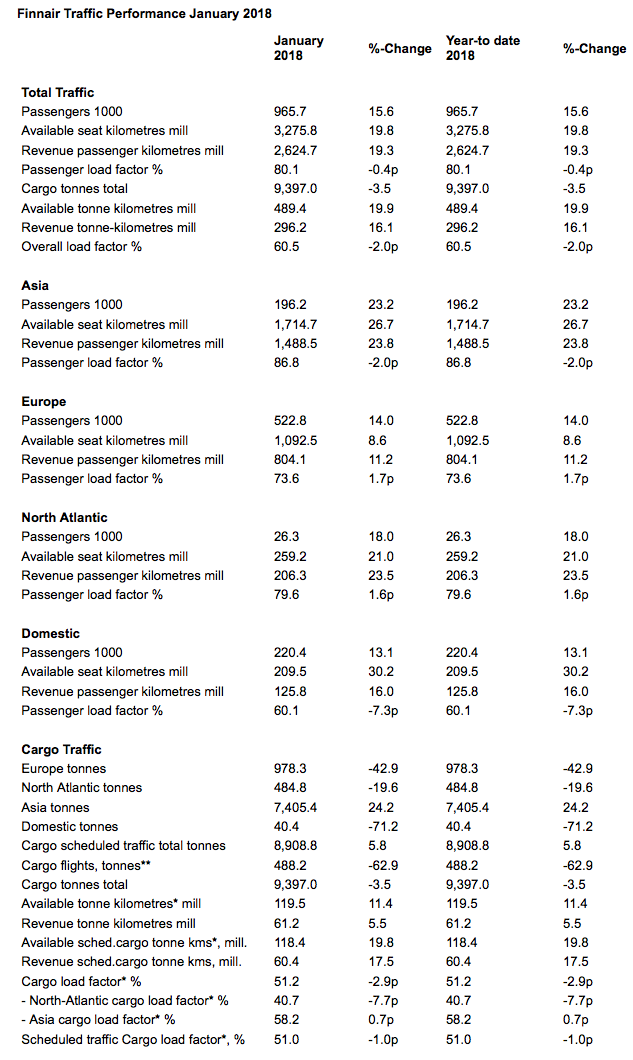The fastest growth in Finnair history in progress - the number of passengers grew by 15.6 per cent in January
In January, Finnair carried 965,700 passengers, or 15.6% more than in the corresponding period of 2017. The number of passengers grew the most in Asian traffic, 23.2%, but growth was also strong on North American routes (+18.0%), European flights (+14.0%) and domestic traffic (+13.1%). More than half of the passengers flew on European flights, more than one fifth on Domestic flights, one fifth on Asian flights and the rest on North American flights.
Finnair's overall capacity measured in Available Seat Kilometres (ASK) increased in January by 19.8% year-on-year. In long-haul traffic, the capacity was increased mainly by the A350 aircraft introduced after the reference period. Additional capacity was allocated to additional frequencies to Bangkok, Hong Kong, Singapore and Chongqing, as well as to new seasonal routes to Goa, Puerto Plata, Puerto Vallarta and Havana, which replaced Varadero that was operated in the reference period. The ASK growth in Asian traffic was 26.7% and in North American traffic 21.0%.
The 8.6% ASK growth in European traffic derived from the increase in the narrow-body fleet size year-on-year and the additional seating capacity added to some if its existing narrow-body aircraft. Capacity growth was directed at serving the new year-round destination Reykjavik, added frequencies especially to Stockholm, Copenhagen and Berlin and direct flights to Lapland from Paris, London and Zurich. The significant ASK growth in domestic traffic, +30.2%, reflects primarily added capacity to destinations in Northern Finland and shows Finnair’s contribution to boosting international tourism in Lapland. In January, 52% of Finnair's ASKs were in Asian traffic, 33% on European routes and the rest in North American and domestic traffic.
Finnair's traffic measured in Revenue Passenger Kilometres (RPKs) grew almost at the same pace with capacity growth, +19.3%. The fastest RPK growth was in Asian traffic, +23.8%. European traffic grew by 11.2%, North American traffic by 23.4% and domestic traffic by 16.0%. Despite of the strong capacity growth, the aircraft flew full especially on long-haul routes - the Passenger Load Factor (PLF) was 86.8% in Asian traffic and 79.6% in North American traffic. In European traffic, PLF was 73.6% and in domestic traffic 60.1%. PLF in total traffic was at the same level as in the comparison period, 80.1% (-0.4%-points year-on-year).
Available Scheduled Cargo Tonne Kilometres increased by 19.8% year-on-year. Revenue Scheduled Cargo Tonne Kilometres increased by 17.5% driven by the good cargo market development in China and Finland. Finnair’s total cargo capacity also included three weekly freighter flights between Helsinki and Brussels, operated by DHL. Cargo flight volumes decreased from the comparison period, when Finnair rented cargo space from Japan Airlines. Finnair’s new COOL Nordic Cargo terminal was taken in full use in January.
Difficult winter conditions at Finnair's home hub Helsinki-Vantaa caused several delays and cancellations in January, and 69.4% of all Finnair flights arrived on schedule (75.8).
Traffic statistics for February 2018 will be published on Wednesday, 7 March 2018.

